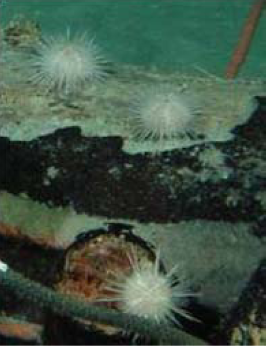
The Aspidodiadematidae are a family of sea urchins.
The World Register of Marine Species (WoRMS) is a taxonomic database that aims to provide an authoritative and comprehensive list of names of marine organisms.

Agassizia is a genus of sea urchin of the family Prenasteridae. The species was first scientifically described in 1869 by Achille Valenciennes.
Acaulospora scrobiculata is a species of fungus in the family Acaulosporaceae. It forms arbuscular mycorrhiza and vesicles in roots. Originally described in Mexico, it is found throughout the world.

The Echinacea are a superorder of sea urchins. They are distinguished by the presence of a rigid test, with ten buccal plates around the mouth, and solid spines. Unlike some other sea urchins, they also possess gills. The group is a large one, with species found worldwide.

Subcancilla scrobiculata is an extinct species of sea snail, a marine gastropod mollusk in the family Mitridae, the miters or miter snails.

Cancilla is a genus of sea snails, marine gastropod mollusks in the family Mitridae.

Vaughtia is a genus of sea snails, marine gastropod mollusks in the family Muricidae, the murex snails or rock snails.
Alvania scrobiculata is a species of minute sea snail, marine gastropod mollusk or micromollusk in the family Rissoidae.

The Camarodonta are an order of globular sea urchins in the class Echinoidea. The fossil record shows that camarodonts have been in existence since the Lower Cretaceous.
Agassizia excentrica is a species of sea urchin of the family Prenasteridae. The species was first scientifically described in 1869 by Alexander Agassiz.
Amblypneustes leucoglobus is a species of sea urchin of the family Temnopleuridae. Their armour is covered with spines. It is in the genus Amblypneustes and lives in the sea. Amblypneustes leucoglobus was first scientifically described in 1914 by Ludwig Döderlein.

Aporocidaris usarpi is a species of sea urchin of the family Ctenocidaridae. Their armour is covered with spines. It is placed in the genus Aporocidaris and lives in the sea. Aporocidaris usarpi was first scientifically described in 2000 by Mooi, David, Fell & Choné.

Echinometra is a genus of sea urchins in the family Echinometridae.
Aspidodiadema montanum is a species of sea urchin of the family Aspidodiadematidae. Their armour is covered with spines. It is placed in the genus Aspidodiadema and lives in the sea. Aspidodiadema montanum was first scientifically described in 1981 by Mironov.

Asterechinus elegans is a species of sea urchin of the family Trigonocidaridae. Their armour is covered with spines. It is the only species in the genus Asterechinus and lives in the sea. Asterechinus elegans was first scientifically described in 1942 by Ole Theodor Jensen Mortensen.

Astriclypeus mannii is a species of sea urchin of the family Astriclypeidae. Their armour is covered with spines. It is placed in the genus Astriclypeus and lives in the sea. Astriclypeus mannii was first scientifically described in 1867 by Verrill.

Breynia elegans is a species of sea urchins of the family Loveniidae. Their armour is covered with spines. Breynia elegans was first scientifically described in 1948 by Ole Theodor Jensen Mortensen.
Chaetodiadema japonicum is a species of sea urchins of the Family Diadematidae. Their armor is covered with spines. Chaetodiadema japonicum was first scientifically described in 1904 by Ole Theodor Jensen Mortensen.

The infraclassis Carinacea includes most living species of regular sea urchin, and fossil forms going back as far as the Triassic.













